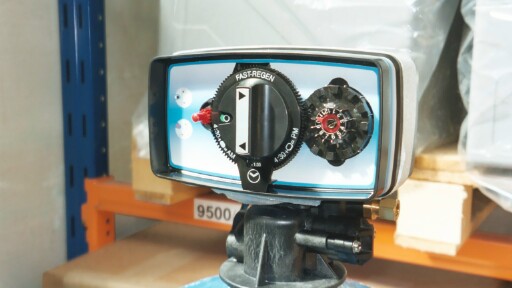Company profile
Chemicals
Plant & equipment
Legionnaires' disease
Contact us
Links
Ion exchange systems The presence of Nitrates in water causes many problems, ranging from 'blue baby' syndrome (if fed to babies under six months old) to contaimination of poultry if used as feed water for farmed birds. The source of Nitrate in ground water is usually from farming fertilisers. The EC permitted maximum is 50 mg/l with an advisory maximum of 25 mg/l.
The presence of Nitrates in water causes many problems, ranging from 'blue baby' syndrome (if fed to babies under six months old) to contaimination of poultry if used as feed water for farmed birds. The source of Nitrate in ground water is usually from farming fertilisers. The EC permitted maximum is 50 mg/l with an advisory maximum of 25 mg/l.Nitrate dissolved in water is removed using either Ion exchange or Reverse Osmosis. It can not be removed by simple filtration. RO systems can be used to treat all of the water for a specific application or to just remove the Nitrates from a drinking water supply in the kitchen. For single dwellings with one drinking water tap and low water consumption, a point of use disposable cartridge system provides efficient nitrate reduction at low cost. For large or multiple properties, commercial and industrial applications, regenerable ion exchange systems will be preferred. It is these systems that are illustrated below.
How do Nitrate removal systems work? Ion exchange Nitrate removal is a similar process to water softening using a slightly different polymer resin. The resin removes the Nitrate (and Sulphate due to its chemical similarity) from the water and replaces them with Chloride ions. Once the resin bed is nearly exhausted of Chloride ions, the control valve carries out a regeneration of the bed.
Ion exchange Nitrate removal is a similar process to water softening using a slightly different polymer resin. The resin removes the Nitrate (and Sulphate due to its chemical similarity) from the water and replaces them with Chloride ions. Once the resin bed is nearly exhausted of Chloride ions, the control valve carries out a regeneration of the bed.This is achieved by passing a Chloride rich brine solution (made up of common salt dissolved in water) through the resin bed, which flushes the Nitrate and Sulphate to drain, replacing them with Chloride ions again. After a final rinse to remove excess brine the unit is automatically put back into service again. The only input required by the user is to ensure that the brine tank is kept topped up with salt. For fixed or consistent flow rates a simple timer controlled valve will suffice. This will effect regeneration of the resin bed at a pre-set time interval. For varying demands a water meter controlled unit is more suitable, regenerating only after a set volume of water has been passed through the resin bed. With applications that require continuous high flows a duty standby "duplex" system will be required.
System Management The choice of valve is entirely dependent upon the application, water use rate and severity of Nirate contamination. Take advice on the best option for your particular problem. Top of the range microprocessor controlled units use very little salt, are able to cope easily with varying demand and remove 90 - 93% of the Nitrates present in the water. Simpler, lower specification valves remove between 80 to 85% of the Nitrate present. The nitrate removal units can be purchased in either meter or timeclock control and are normally suited to most domestic applications with a Nitrate level not in excess of 100 mg/l.
The choice of valve is entirely dependent upon the application, water use rate and severity of Nirate contamination. Take advice on the best option for your particular problem. Top of the range microprocessor controlled units use very little salt, are able to cope easily with varying demand and remove 90 - 93% of the Nitrates present in the water. Simpler, lower specification valves remove between 80 to 85% of the Nitrate present. The nitrate removal units can be purchased in either meter or timeclock control and are normally suited to most domestic applications with a Nitrate level not in excess of 100 mg/l.
Domestic and Commercial Nitrate Reduction UnitsSystem Management and RegenerationRegeneration is controlled by a valve mounted on top of the pressure vessel containing the resin. A solution of brine is drawn through the column and the chloride from the salt displaces the Nitrate and Sulphate ions flushing them down the drain. The regeneration process can be initiated by a time clock or by a meter. The latter regenerates the resin after a pre-set volume of water has been treated.
Specifying and SizingThe capacity of a Nitrate removal unit is a function of the amount of resin in the column, the amount of Nitrate and Sulphate in the water, and the amount of salt used at each regeneration. The output will therefore increase or decrease according to local circumstances and the salt dosage rate. The raw water can also change dramatically in composition depending on the season and weather conditions, so again take advice on the potential variations when fitting and progamming your Nitrate Removal Unit.
Technical Details and Part NumbersAvailable on request.Domestic/low flow system are usually assembled into a cabinet which also acts as a brine tank. Commercial and Industrial Nitrate Removal Units are built with seperate brine tanks, and can be Simplex systems (single resin column) or duty standby Duplex systems (twin resin columns). The systems will be assembled with the most suitable valve for your peak flow rate. Again take advice on what best meets your circumstances.
Commercial Systems - Technical DataAvailable on request.
|